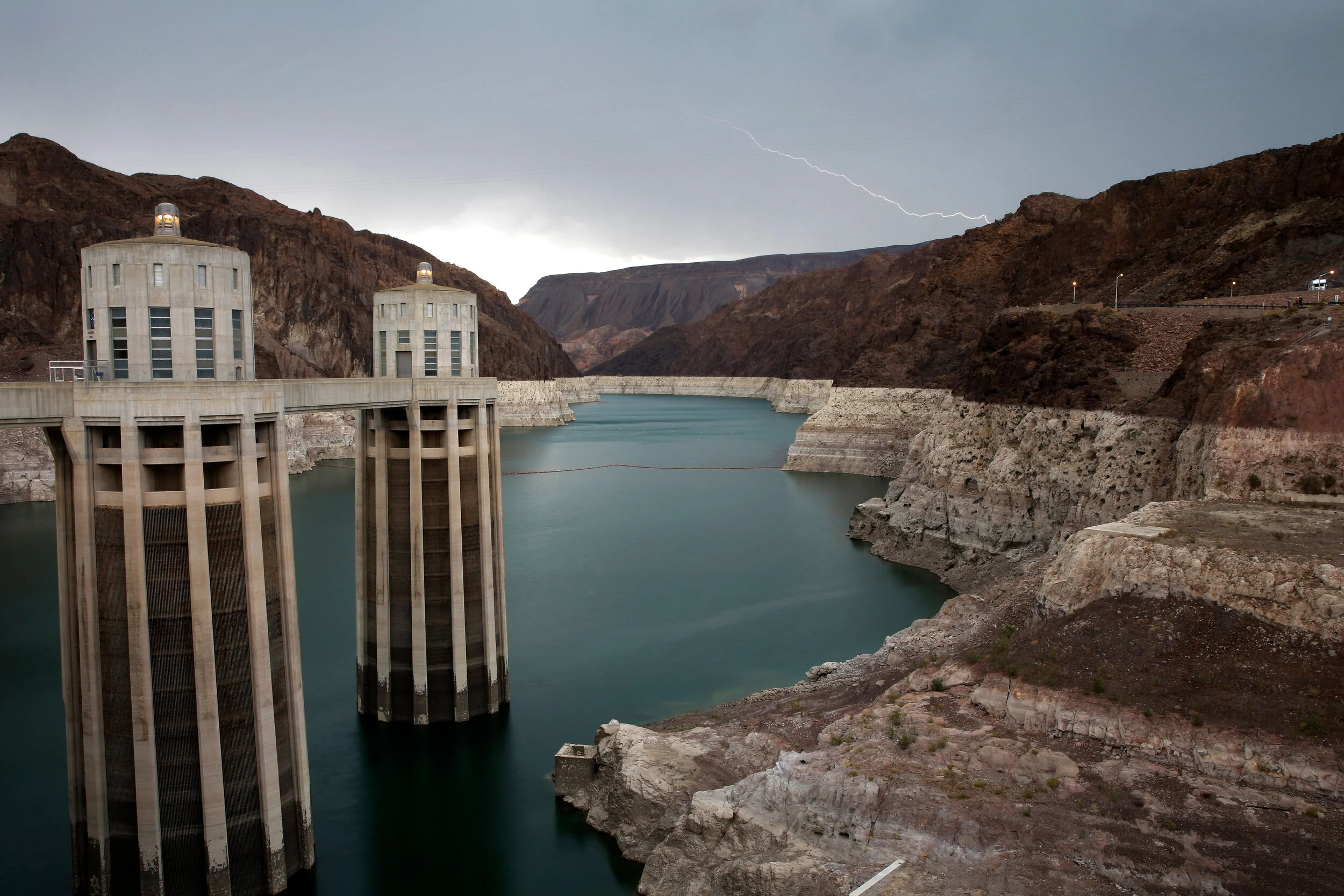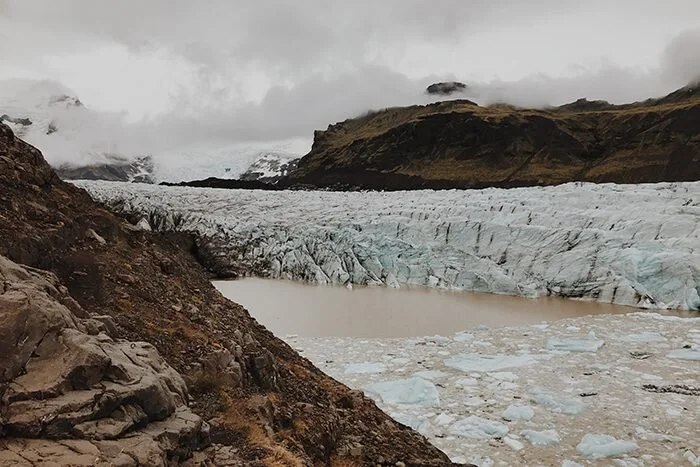Running Dry
The American Southwest: On The Verge Of Environmental Collapse?
By Dan Lennon
Lake Mead is now at its lowest level since the dam was built. It is at just 36% of capacity. It provides water for agriculture and cities in three states – California, Arizona, and Nevada. It also provides electricity for 1.3 million people. At capacity, the lake is at 1,229 feet and holds over 10 trillion gallons of water. It is now 143 feet below that and is at an elevation of 1,077 feet. At an elevation of 1,050 feet, it will have lost 6.8 trillion gallons of water. It will only take a drop of an additional 2.7 trillion gallons to reduce the water level to 895 feet, at which point it will no longer produce electricity or water.
Lake Mead / Credit: Felton Davis, FlickrCC
Lake Mead receives the majority of its water from snow melt in the Colorado, Wyoming, and Utah Rocky Mountains. Inflows to the lake are largely moderated by the upstream Glen Canyon Dam which forms the Lake Powell reservoir, which is also enormous, but slightly smaller in volume than Lake Mead.
The Glen Canyon dam is required to release 2.7 trillion gallons per year to Lake Mead, but Lake Powell is also suffering from the drought and is at only 35% capacity. The water is at an elevation of 3,556 feet. If it drops another 34 feet, it will stop generating power.
The inflow volume to Lake Powell during July was 68 billion gallons – just 19% of the average. The release volume from Glen Canyon Dam in July was 250 billion gallons, for a net deficit of 182 billion gallons. The Glen Canyon dam has reduced the amount of water it releases to Lake Mead below the required minimum in order to keep its own water up. Reservoirs upstream from Lake Powell are releasing more water to keep it functional, but it is robbing Peter to pay Paul.
Snowpack in the Colorado Rockies, with some fluctuations, continues to fall. Since nothing has been done to reduce fossil fuel emissions to any meaningful extent (wind and solar combined supply less than 3% of the world’s energy needs), the planet will continue to heat more and more rapidly, and drought conditions will continue to worsen.
Temporizing measures in Las Vegas, like recycling wastewater and reducing consumption, and at Lake Mead, like installing more efficient turbines and a water intake at the 860-foot level, will help stretch out the water supply, but the climate in the Southwest, always arid, is becoming more arid thanks to global warming. The question is not if Lake Mead will run dry, but when. The consequences to the American Southwest will be catastrophic, and those who can relocate will. This migration of millions of people will itself be a crisis of enormous proportions. It has already begun and will pick up pace as conditions worsen over the next several years. By 2030 or sooner, it will be well underway.
The 1.5-degree Celsius threshold which will signify that we have reached the point of no return, once thought to be a few decades off, is now expected to occur as soon as 2025. What most people cannot comprehend is this sudden acceleration of climate change which will overtake us this decade. The Southwest will be the first to bear the brunt, but eventually it will affect the entire country.
The best places to live as the climate warms will be in the states bordering Canada and the Great Lakes. As areas of Canada, previously sparsely populated because of the frigid climate, become more hospitable, it will be a destination for climate migrants from the US. Alaska too will become a desirable place to which to relocate. It promises to be the center of commerce and government for a drastically changed United States. With climate change unchecked, the entire lower 48 states will eventually become a desert sometime in the next century.
There is one tiny ray of hope, and that is Solar Radiation Management (SRM). It refers to techniques to reduce the amount of solar radiation hitting the Earth. The most researched and promising technology is Stratospheric Aerosol Injection (SAI). This involves dispersing aerosols into the stratosphere to block sunlight. The aerosol of choice has been sulfur dioxide, the same compound emitted by volcanoes. The problem with it, however, is that it causes acid rain. Harvard University has had a research project underway since 2014 which aims to disperse calcium carbonate instead of sulfur dioxide. It does not have sulfur dioxide’s negative impact and it reflects more light.
In order to make this strategy feasible, the aircraft dispersing the aerosol must fly into the stratosphere – an altitude of 65,000 feet. Currently that is the maximum altitude for advanced fighter aircraft. The aircraft required to disperse the aerosol must be large enough to carry a heavy load. These do not exist, but the aerospace industry says that they would not be hard to develop.
The eruption of Mount Pinatubo in 1991in the Philippines emitted 20 million tons of sulfur dioxide. It cooled the Earth by one degree for two years. A 747 has a maximum load carrying capacity of one quarter of a million tons. This means that it would only take 80 flights of an aircraft of this size to disperse 20 million tons. That isn’t many flights. Since the lighter the aircraft the easier is to reach 65,000 feet, it would be feasible to build aircraft that can carry, say, 100,000 pounds. This would require 200 flights. Still quite doable. The aerosol would last for between 1 and 4 years, so the dispersal process would have to be repeated on an interval in that range.
One downside is that it is a massive global experiment and could have some untoward effects, but compared to letting the planet incinerate itself, it is a risk worth taking. Another downside is that it could take the pressure off and lead people to not take the need to reduce emissions seriously. And a third downside is that our survival would depend on the regular distribution of aerosols. If for some reason we were not able to continue, the planet would begin to warm even faster due to the emissions that accumulated in the meantime.
AT almost eight billion people on the planet, the energy demands can only be reduced by so much through austerity. The remaining energy is essential to the lifestyle we have built. Ultimately we cannot tech our way out of this. We must reduce the human population to about one billion people. Unfortunately, the ravages of global warming will do this for us.






